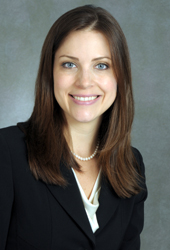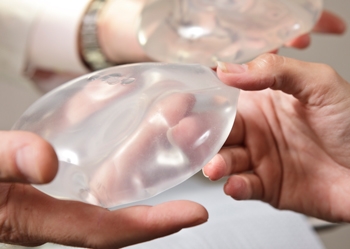There has been a tremendous amount of talk about breast implants in the news and on social media recently. Last month, the Food and Drug Administration (FDA) convened an advisory panel to discuss the long-term benefits and risks of breast implants for both breast augmentation as well as reconstruction.
Breast implants have a decades-long history. The first "mammaplasty" procedure using implants — was performed in 1962. The implants, then, were a silicone rubber envelope-sac, shaped like a teardrop, which was filled with viscous silicone-gel.
Implants have evolved and improved over time. Now breast implantation is one of the most popular forms of plastic surgery done in the United States. In 1976, the FDA started to regulate silicone breast implants, subjecting them to controls and performance standards.
Here, Tara L. Huston, MD, associate professor of surgery and a member of our Plastic and Reconstructive Surgery Division, answers frequently asked questions about breast implants. The information she provides is essential for women who already have or are considering getting breast implants.
Q: What is the purpose of breast implants?
A: Breast implants are medical devices used to increase the size and change the shape of the breast. For women who undergo mastectomy for breast cancer, they are the most commonly used method of recreating a breast (reconstructive purpose). For women who desire larger breasts, they are placed behind the existing tissue to augment cup size (cosmetic purpose).
Q: What exactly is a breast implant made of, and what are the different types?
A: The breast implant shell is composed of silicone. The inside fill can be either saline (salt water) or silicone gel. From 1994 to 2006, the FDA did not allow the placement of silicone-filled implants in the United States for cosmetic purposes.
During this time, the FDA collected data and concluded that there was no increased risk of connective tissue disorders. Since 2006, both saline and silicone implants were permitted to be used for reconstructive and cosmetic purposes.
Q: What is the difference between a smooth and a textured breast implant?
A: The difference is in the appearance and feel of the shell. Smooth implants have a soft, uniform shell and tend to move more as the capsule doesn't grow into them. Textured implants have a coating, creating in a larger surface area, which causes the capsule to grow them and results in less movement.
Q: What complications can occur with the implants themselves?
A: Local complications include capsular contracture, malposition, and rupture. Some people also experience breast pain, wrinkling, asymmetry, scarring and infection.
Q: What conditions are associated with having breast implants?
A: Breast implant-associated anaplastic large cell lymphoma and an entity known as breast implant illness.
Q: What is anaplastic large cell lymphoma?A: Breast implant-associated anaplastic large cell lymphoma, known by the abbreviation BIA-ALCL, is a cancer of the immune system which is most often found in the capsule around the implant. It is NOT a breast cancer.
There have been 673 cases worldwide reported to date. While most patients with BIA-ALCL have been treated with only breast implant removal, some patients have required radiation therapy, chemotherapy, or both, and 16 patients have died from BIA-ALCL.
Incidence estimates are highly variable but range from roughly 1 in 3,000 patients to 1 in 30,000 patients with textured implants.
There are no confirmed cases of BIA-ALCL in women with smooth implants. BIA-ALCL has been reported in both silicone- and saline-filled implants. It is the textured shell that seems to be the issue, and not the fill.
If you have any issues, questions, or concerns, please arrange for a consultation with
one of our plastic surgeons to help you by calling our office at 631-444-8210.
Q: What does a woman with breast implants need to look out for in regard to BIA-ALCL?
A: BIA-ALCL usually develops as a swelling of the breast 2 to 28 years after the insertion of breast implants. It most commonly presents as a fluid collecting around the implant. It can also present as a lump in the breast or armpit. If a woman with implants notes that only one breast is enlarging, this is an indication to see a plastic surgeon for an evaluation.
Q: What is breast implant illness?
A: There are many breast implant patients on social media who discuss a wide variety of symptoms that they are experiencing — symptoms which may or may not meet the diagnostic criteria to be categorized as a disease.
These patients refer to their symptoms collectively as "breast implant illness." However, there currently is not sufficient evidence to demonstrate an association between breast implants and rheumatologic or connective tissue diseases.
Q: What is the follow-up needed for women with breast implants?
A: Once the plastic surgeon has established that a woman has healed, and her implants have settled, she does not need yearly follow-up just because she has breast implants. However, if the implants were placed for reconstruction following cancer surgery, we do ask patients to see their surgeons yearly.
Asymptomatic women without breast changes do not require more than routine follow-up with their primary physician or gynecologist for a yearly breast exam.
If a woman with breast implants experiences a change in her breasts — especially if there is swelling or a lump — she should undergo examination and appropriate imaging, including ultrasound and fine-needle aspiration of any peri-implant fluid.
The woman who understands the risks as well as benefits of breast implants, and knows
what danger signs to look out for, is the best possible breast advocate for herself.
Q: Does a woman with implants need frequent MRI exams to check them?
A: As of last week, the FDA's prior recommendation of MRI screening at three years after implant placement and every two years thereafter was called into question. A breast implant MRI study is rarely covered by insurance companies and only looks at the implant, not the surrounding breast tissue.
Even if a silent rupture is identified, most women will not undergo surgery if they are not experiencing issues.
The recommendations are moving toward ultrasound, beginning at least five years after the implants are placed.
Ultrasound is a good test to look for capsule thickening and peri-implant fluid. If there is a silent rupture suspected on ultrasound, an MRI can further characterize but it is no longer considered the first-line imaging test for screening.
Q: Does having implants change a woman's breast cancer screening?
A: No. It is still recommended that women have a baseline screening mammogram at age 35 and then begin yearly mammograms at age 40. If you have dense breasts, a yearly ultrasound may be recommended in addition.
Q: Is there an expiration date on current breast implants?
A: No ten-year "time limit" exists at which time implants expire and must be removed or replaced. If a woman with breast implants is not experiencing issues, it is unlikely she will need to have another operation.
Q: If a woman wants to remove her breast implants, will health insurance cover the procedure?
A: Breast augmentation is considered cosmetic, and is not covered by insurance companies. As such, removal of breast implants also is not commonly covered by insurance companies. An exception is in the case of previous or current cancer diagnosis for which they will often cover implant surgery.
Q: What is the take home message for women who already have or are considering getting breast implants?
A: Breast implants are not lifetime devices. They will likely require maintenance such as an additional operation at some point. The longer a woman has breast implants, the more likely she is to experience local complications or adverse outcomes requiring re-operation.By being an informed consumer, understanding the risks as well as benefits, and knowing what danger signs to look out for, a woman with breast implants is the best possible breast advocate for herself!



